“It is all about the stones” -Kathryn.
Gemstone Information
Aquamarine

History:
During the middle ages, europeans believed this gem gave its wearer wisdom and inspiration, power to overcome evil, and the ability to see the future. According to other traditions, aquamarine creates harmony and ensures a long, happy marriage.
Color:
Usually light blue-green to slightly greenish blue
Toughness:
Good resistance to chipping and breaking
Chalcedony
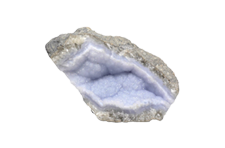
History:
Treasured by humans since prehistoric times, chalcedonies were sacred and royal gemstones in early civilizations around the world. They were also used in Europe as a charm against ghosts.
Color:
The range of color is almost unlimited (frequently seen in shades of blue and green).
Sources:
There are many worldwide sources including Australia, Brazil, India, Russia, Uruguay, and the U.S
Toughness:
Good resistance to chipping and breaking
Citrine

History:
According to old legends, citrine has the power to guard its wearer from evil thoughts. The name comes from Latin citrus meaning citron, a fruit related to lemon, lime, and orange.
Color:
The color is light yellow to dark orange (sometimes brownish).
Sources:
Most citrine comes from Brazil. Other sources include Bolivia, India, Madagascar, Myanmar, Russia, And Sri Lanka.
Toughness:
Good resistance to chipping and breaking
Drusy

History:
Drusy is a natural formation of crystal on a stone surface, the process of crystallization, which often occurs when water collects and leaves minerals on a rock over many years. When the water evaporates, cooling occurs, and the minerals are left behind to form crystals on top of the rock. Drusy can be formed on a multitude of base gemstones, therefore the color will vary.
Sources:
Most of the drusy used in Jabez Jewelz designs have originated from Indonesia or Brazil.
Toughness:
Varies due to multitude of ‘gem ‘base stones.
Garnet

History:
Traditionally symbolizes faith, truth, friendship, and loyalty. Additionally, for centuries the garnet was believed to dispel fear, soothe discord, ensure guidance, protect travelers, and inspire deep affection.
Color:
Although history’s arnets were limited to shades of red, todav’s aarnets have many tones and intensities of red. purple. pink, orange, yellow, and green.
Sources:
The garnet is found worldwide in countries including Australia, Brazil, China, India, Kenya, Madagascar, Namibia, Nigeria, Russia, Sri Lanka, Tanzania, and Zambia.
Toughness:
Good resistance to chipping and breaking
Malachite
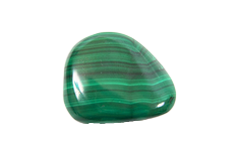
History:
By about 4000 BC the egyptians were using malachite to make jewelry, carvings, and other objects for ornamental and religious functions. According to a book about gems written in the 1500s, attaching a piece of malachite to a baby’s cradle would drive away evil spirits and ensure good sleep. Other stories say malachite protect its wearer from falls and sorcerers’ spells
Color:
Light to dark green or bluish green with attractive bands of different shades.
Sources:
The most important source is Zaire. There are others worldwide, including Australia, Chile, China, Namibia, Russia, South Africa, and the U.S.
Toughness:
Good resistance to chipping and breaking
Moonstone

History:
According to the folklore of ancient India, moonstone is made of crystallized moonbeams. Other cultures have also connected this stone to the moon, therefore the gem’s name genuinely reflects this time-honored association. One old story says if you hold a moonstone in your mouth under the light of the full moon, you’ll be able to see your future.
Color:
Typically colorless, white or gray. Can also be light yellow, orange or brown. (The moonstone displays a glow that seems to float inside the gem. The effect is technically known as adularescence.)
Sources:
Australia, Brazil, India, Madagascar, Myanmar, Sri Lanka, and Tanzania. India is the main source of rainbow moon-stone.
Toughness:
Good resistance to chipping and breaking
Nephrite/Jade
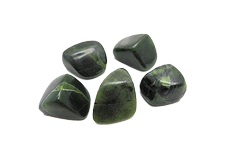
History:
Treasured by humans since prehistoric times, chalcedonies were sacred and royal gemstones in early civilizations around the world. They were also used in Europe as a charm against ghosts.
Color:
The brightest nephrite is often described as a “spinach” color, however, it also comes in various shades of green, lavender, yellow, orange, and brown.
Sources:
Canada and U.S. are leading sources.
Toughness:
Good resistance to chipping and breaking
Opal
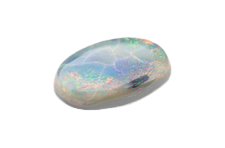
History:
The opal has been highly valued by Western cultures for since before the Romans. In Kenya, anthropologists have found opal artifacts 6,000 years old, and 500 years ago, the Aztecs mined opal in Central America. The opal is traditionally considered the most magic of gems because it shows the colors of all others combined. According to Middle Eastern folklore, the opal and its flashing colors is born from lightning. In Europe, opal has long symbolized purity and hope.
Colors:
Full range includes white, gray, black, red, orange, yellow and brown.
White Opal – Translucent to opaque white or light gray with play-of-color.
Black Opal – Translucent to opaque with play-of-color on a base or some other dark color.
Crystal Opal – Transparent with play-of-color on a colorless to dark gray base.
Fire Opal – Transparent to translucent red, orange, yellow, or brown.
“Play-of-color” occurs because the opal has a unique structure. It is made of minute spheres that break up white light into spectral hues.
Sources:
Australia is by far the world’s most important producer of white, black, and crystal opal. Brazil and Mexico are significant sources of white and fire opal. Others include Honduras, Madagascar, Tanzania, and the U.S.
Toughness:
Good resistance to chipping and breaking
Peridot

History:
Called “Gem of the Sun” by the Egyptians. According to old legends, prospectors looked for peridot at night and located the crystals by their glow. Magical attributes include power to attract wealth and drive away evil spirits.
Color:
Light to dark green.
Sources:
Australia is by far the world’s most important producer of white, black, and crystal opal. Brazil and Mexico are significant sources of white and fire opal. Others include honduras, madagascar, tanzania, and the U.S.
Toughness:
Good resistance to chipping and breaking
Peruvian Opal
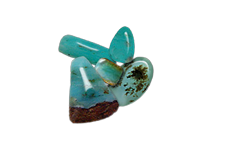
History:
This stone is an excellent stone for calming the mind and is considered useful for a good nights sleep. Tradition says that it can take away tension from communications and will allow ideas to flow generously.
Color:
This gemstone is usually blue to blue-green. The stones may enclose dark inclusions that look like ferns. Its internal crystalline composition is random, meaning this gemstone lacks the color play or fire of a usual opal.
Sources:
Peruvian Opal is the national stone of Peru and it is relatively rare. It can only be found in the Andes Mountains.
Toughness:
Usually good resistance to breaking, but nacre can be chipped or broken fairly easily
Pearl

History:
Historically, the pearl is known as the most beautiful and magical of gems. In the ancient world, pearls were most likely discovered while searching for food, and had the greatest value of all material things. For centuries, people in Asia believed pearls begin with drops of divine moisture that fall from dragons in the sky. When the drops land in seashells and are nourished by moonbeams, they grow into pearls. Due to their appearance and origin, pearls have always been associated with the moon and water. From these natural links they grew to symbolize purity and love.
Color:
Typical colors are white and cream, but others can include pink, yellow, blue and gray.
Sources:
Akoya-the most popular and familiar of pearls is produced mainly along the coasts of Japan and China.
Toughness:
Usually good resistance to breaking, but nacre can be chipped or broken fairly easily
Star Ruby
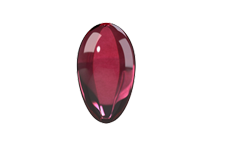
History:
According to traditions in the Middle East and Orient, star rubies protect wearers from evil and bring them good fortune. The star is said to be a spirit of light that dwells within the gem.
Color:
Light to dark red. The stone displays three intercepting bands of light that form a six-rayed star. In fine quality the star is sharp, bright, and centered.
Toughness:
Usually good resistance to breaking, but nacre can be chipped or broken fairly easily
Turquoise
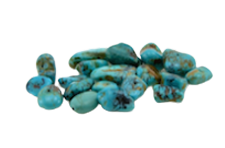
History:
Strongly associated with native cultures of the southwest, turquoise is considered the “most american gem
Color:
Light blue to bluish-green. Turquoise may show spangles caused by inclusions of the mineral pyrite (fool’s gold).
Toughness:
Resistance to chipping and breaking is usually good to fair.
(Source: DCA Colored Gemstone Compendium)
Topaz

History:
The name comes from Sanskrit topas, a classical literary and sacred language of India; which means fire.
Color:
The topaz comes in many shades of color.
Toughness:
Low resistance to chipping and breaking
Aquamarine

History: During The Middle Ages, Europeans Believed This Gem Gave Its Wearer Wisdom And Inspiration, Power To Overcome Evil, And The Ability To See The Future. According To Other Traditions, Aquamarine Creates Harmony And Ensures A Long, Happy Marriage.
Color: Usually light blue-green to slightly greenish blue
Toughness: Good resistance to chipping and breaking
Chalcedony

History: Treasured by humans since prehistoric times, chalcedonies were sacred and royal gemstones in early civilizations around the world. They were also used in Europe as a charm against ghosts.
Color: The range of color is almost unlimited (frequently seen in shades of blue and green).
Sources: There are many worldwide sources including Australia, Brazil, India, Russia, Uruguay, and the U.S.
Toughness: Good resistance to chipping and breaking
Citrine

History: According to old legends, citrine has the power to guard its wearer from evil thoughts. The name comes from Latin citrus meaning citron, a fruit related to lemon, lime, and orange.
Color: The color is light yellow to dark orange (sometimes brownish).
Sources:Most citrine comes from Brazil. Other sources include Bolivia, India, Madagascar, Myanmar, Russia, And Sri Lanka.
Toughness: Good resistance to chipping and breaking
Garnet

History: Traditionally symbolizes faith, truth, friendship, and loyalty. Additionally, for centuries the garnet was believed to dispel fear, soothe discord, ensure guidance, protect travelers, and inspire deep affection.
Color: Although history’s aarnets were limited to shades of red, todav’s aarnets have many tones and intensities of red. purple. pink, orange, yellow, and green.
Sources: The garnet is found worldwide in countries including Australia, Brazil, China, India, Kenya, Madagascar, Namibia, Nigeria, Russia, Sri Lanka, Tanzania, and Zambia.
Toughness: Good resistance to chipping and breaking
Nephrite/Jade

History: Treasured by humans since prehistoric times, chalcedonies were sacred and royal gemstones in early civilizations around the world. They were also used in Europe as a charm against ghosts.
Color: The brightest nephrite is often described as a “spinach” color, however, it also comes in various shades of green, lavender, yellow, orange, and brown.
Sources:Canada and U.S. are leading sources.
Toughness: Good resistance to chipping and breaking
Malachite

History: By about 4000 BC the Egyptians were using malachite to make jewelry, carvings, and other objects for ornamental and religious functions. According to a book about gems written in the 1500s, attaching a piece of malachite to a baby’s cradle would drive away evil spirits and ensure good sleep. Other stories say malachite protect its wearer from falls and sorcerers’ spells.
Color: Light to dark green or bluish green with attractive bands of different shades.
Sources:The most important source is Zaire. There are others worldwide, including Australia, Chile, China, Namibia, Russia, South Africa, and the U.S.
Toughness: Good resistance to chipping and breaking
Moonstone

History: According to the folklore of ancient India, moonstone is made of crystallized moonbeams. Other cultures have also con-nected this stone to the moon, therefore the gem’s name genuinely reflects this time-honored association. One old story says if you hold a moonstone in your mouth under the light of the full moon, you’ll be able to see your future.
Color: Typically colorless, white or gray. Can also be light yellow, orange or brown. (The moonstone displays a glow that seems to float inside the gem. The effect is technically known as adularescence.)
Sources: Australia, Brazil, India, Madagascar, Myanmar, Sri Lanka, and Tanzania. India is the main source of rainbow moon-stone.
Toughness: Good resistance to chipping and breaking
Turquoise

History: Strongly associated with native cultures of the southwest, turquoise is considered the “most American gem.
Color: Light blue to bluish-green. Turquoise may show spangles caused by inclusions of the mineral pyrite (fool’s gold).
Toughness: Resistance to chipping and breaking is usually good to fair.
(Source: DCA Colored Gemstone Compendium)
Topaz

History: The name comes from Sanskrit topas, a classical literary and sacred language of India; which means fire.
Color: The topaz comes in many shades of color.
Toughness: Low resistance to chipping and breaking
Peridot

History: Called “Gem of the Sun” by the Egyptians. According to old legends, prospectors looked for Peridot at night and located the crystals by their glow. Magical attributes include power to attract wealth and drive away evil spirits.
Color: Light to dark green.
Sources: Australia is by far the world’s most important producer of white, black, and crystal opal. Brazil and Mexico are signifi-cant sources of white and fire opal. Others include Honduras, Madagascar, Tanzania, and the U.S.
Toughness: Good resistance to chipping and breaking
Peruvian Opal

History: This stone is an excellent stone for calming the mind and is considered useful for a good nights sleep. Tradition says that it can take away tension from communications and will allow ideas to flow generously.
Color: This gemstone is usually blue to blue-green. The stones may enclose dark inclusions that look like ferns. Its internal crys-talline composition is random, meaning this gemstone lacks the color play or fire of a usual opal.
Sources: Peruvian Opal is the national stone of Peru and it is relatively rare. It can only be found in the Andes Mountains.
Toughness:Usually good resistance to breaking, but nacre can be chipped or broken fairly easily
Star Ruby

History: According to traditions in the Middle East and Orient, star rubies protect wearers from evil and bring them good fortune. The star is said to be a spirit of light that dwells within the gem.
Color: Light to dark red. The stone displays three intercepting bands of light that form a six-rayed star. In fine quality the star is sharp, bright, and centered.
Toughness:Usually good resistance to breaking, but nacre can be chipped or broken fairly easily
Pearl

History: Historically, the pearl is known as the most beautiful and magical of gems. In the ancient world, pearls were most likely discovered while searching for food, and had the greatest value of all material things. For centuries, people in Asia believed pearls begin with drops of divine moisture that fall from dragons in the sky. When the drops land in seashells and are nourished by moonbeams, they grow into pearls. Due to their appearance and origin, pearls have always been associated with the moon and water. From these natural links they grew to symbolize purity and love.
Color: Typical colors are white and cream, but others can include pink, yellow, blue and gray.
Sources: Akoya-the most popular and familiar of pearls is produced mainly along the coasts of Japan and China.
Toughness:Usually good resistance to breaking, but nacre can be chipped or broken fairly easily
Opal

History: The opal has been highly valued by Western cultures for since before the Romans. In Kenya, anthropologists have found opal artifacts 6,000 years old, and 500 years ago, the Aztecs mined opal in Central America. The opal is traditionally considered the most magic of gems because it shows the colors of all others combined. According to Middle Eastern folklore, the opal and its flashing colors is born from lightning. In Europe, opal has long symbolized purity and hope.
Colors:Full range includes white, gray, black, red, orange, yellow and brown.
White Opal – Translucent to opaque white or light gray with play-of-color.
Black Opal – Translucent to opaque with play-of-color on a base or some other dark color.
Crystal Opal – Transparent with play-of-color on a colorless to dark gray base.
Fire Opal – Transparent to translucent red, orange, yellow, or brown.
“Play-of-color” occurs because the opal has a unique structure. It is made of minute spheres that break up white light into spectral hues.
Sources: Australia is by far the world’s most important producer of white, black, and crystal opal. Brazil and Mexico are signifi-cant sources of white and fire opal. Others include Honduras, Madagascar, Tanzania, and the U.S.
Toughness: Good resistance to chipping and breaking
